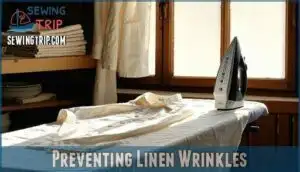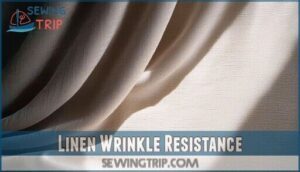This site is supported by our readers. We may earn a commission, at no cost to you, if you purchase through links.
 If you’re wondering, does all linen wrinkle, the answer’s yes—every linen fabric gets creases, but not all are created equal.
If you’re wondering, does all linen wrinkle, the answer’s yes—every linen fabric gets creases, but not all are created equal.
Pure linen is the king of wrinkles, thanks to its stiff fibers, while blends with cotton or polyester stay smoother longer.
Treated linens with special finishes also fight wrinkles better, and even heavyweight linen holds its shape more than lightweight types.
How you wash, dry, and store your linen makes a big difference, too, so while you can’t dodge wrinkles entirely, you can control how rumpled your linen looks.
Stick around for clever tricks to keep your linen looking sharp.
Table Of Contents
Key Takeaways
- You’ll always see some wrinkles in linen, but blends with cotton or polyester stay smoother longer.
- You can minimize creases by ironing linen while it’s damp and hanging it up right after washing.
- Treated and heavyweight linen hold their shape better, so choose these if you want less wrinkling.
- Don’t stress about wrinkles—linen’s natural creases are part of its relaxed style and charm.
Linen Wrinkle Causes
Linen wrinkles because its natural fibers lack elasticity, meaning they can’t easily bounce back to their original shape once bent or twisted.
The specific way your linen wrinkles depends on factors like how tightly it’s woven, the quality of the fibers, and how you wash and dry it, which can be considered a complete concept in understanding linen wrinkles.
Fabric Type
The complexity of linen wrinkles easily depends heavily on fabric type, which determines how your garments behave after washing and wearing.
Pure flax creates the most stubborn creases, while linen blends offer better wrinkle resistance through synthetic fiber integration.
Blended linen lets you skip the iron more often and enjoy effortless style every day
Pure flax wrinkles easily, but blended options give you freedom from constant pressing.
- 100% Flax Linen: Most wrinkle-prone due to rigid fiber structure and lack of elasticity
- Linen Blends: Cotton or polyester mixed fabrics reduce wrinkling by up to 40%
- Treated Linen: Chemical finishes enhance wrinkle resistance by 30% compared to natural versions
- Fiber Quality: Belgian and French varieties with longer fibers show marginally better crease recovery
Weave Density
Your weave density directly affects how much your linen wrinkles.
Tighter weaves with higher yarn density create stronger textile strength, making fabric less prone to creasing.
Loose weaves allow fibers to shift easily, increasing wrinkle formation.
Thread count matters too—higher counts typically mean better linen wrinkle resistance, though they don’t eliminate the natural tendency for linen fabric properties to create those characteristic creases with a natural tendency.
Washing Methods
Your washing approach directly impacts linen’s wrinkle formation.
Machine washing with hot water and aggressive cycles creates deep creases, while gentle cold-water cycles minimize damage.
Hand washing offers the best control for preventing linen wrinkles, allowing careful handling of delicate fibers.
Dry cleaning preserves structure but can’t eliminate natural wrinkling tendencies.
Proper soaking methods and steam washing help maintain linen’s integrity.
Does All Linen Wrinkle

Most linen fabrics wrinkle, but not all types behave the same way.
The short answer? Yes, traditional linen fabric wrinkles easily due to its natural fiber structure.
However, you’ve got options that’ll save your sanity and your schedule.
Here’s what affects linen’s wrinkle behavior:
- Pure linen – Wrinkles most, but feels incredible and breathes beautifully
- Linen blends – Mixed with cotton or polyester for wrinkle-free linen options
- Pre-treated linen – Chemically processed to resist creasing
- Heavyweight linen – Thicker weaves hold their shape better than lightweight versions
Preventing linen wrinkles starts with smart laundry hacks.
Remove items while slightly damp, shake them out, and hang immediately.
These linen care tips work better than fighting wrinkles later.
The truth about linen care? Embrace some wrinkles – they’re part of linen’s charm.
But when you need crisp results, proper ironing tips and fabric softness techniques will get you there.
Remember, does linen always wrinkle? Not if you choose the right type and treat it well.
Linen Fabric Types
Not all linen wrinkles the same way, and understanding different fabric types helps you choose the right option for your needs.
Belgian linen offers exceptional durability with moderate wrinkling, Irish linen provides superior softness but creases easily, while French linen strikes a balance between quality and wrinkle resistance.
Belgian Linen
If you’re wondering why linen fabric wrinkles so easily, Belgian Linen sets the bar for both durability and style.
Thanks to the Belgian Weave and strong Linen Thread, this textile boasts impressive wrinkle resistance.
Its rich Textile History and expert Belgian Crafts mean it ages gracefully, especially with proper linen care tips.
Fabric Dyeing adds character, making linen wrinkles part of its charm.
The high quality of Belgian Linen is due to its use of natural flax fibers which contribute to its durability and style.
Irish Linen
Renowned worldwide, this premium textile showcases centuries-old craftsmanship.
Irish linen clothing wrinkles less than standard varieties due to superior fiber quality and traditional Irish Weave techniques.
Linen History reveals these fabrics resist creasing through:
- Dense thread construction minimizing fold lines
- Natural Celtic Patterns that disguise minor wrinkles
- Expert Fabric Dyeing enhancing fiber resilience
- Traditional Textile Art methods strengthening structure
You’ll find wrinklefree linen options easier with Irish varieties, though proper linen garment care remains essential.
French Linen
France produces some of the world’s finest linen fabric, with exceptional linen quality that comes from centuries of textile history.
French weave techniques create incredibly soft, luxurious fabric that still wrinkles naturally. However, proper linen care helps minimize creasing.
When you iron linen from France, you’ll notice the fabric softness makes wrinkles easier to smooth out than cheaper alternatives, giving you better wrinklefree linen options overall.
Preventing Linen Wrinkles
You don’t have to accept wrinkles as linen’s permanent trademark, even though this natural fiber has a reputation for creasing easily.
With the right techniques for ironing, using spray starch, and proper folding, you can keep your linen looking crisp and polished throughout the day.
Proper Ironing
Proper ironing transforms wrinkled linen into crisp perfection, but technique matters more than temperature alone.
Smart fabric prep and the right steaming methods make all the difference in wrinkle removal.
Follow these ironing tips for flawless results:
- Iron damp linen at 200°C – Moisture helps fibers relax faster
- Press inside-out using straight strokes – Prevents shine and distortion
- Use a damp press cloth – Protects delicate fibers from scorching
Using an ironing board accessory can enhance ironing efficiency.
Remember: good iron maintenance keeps your equipment performing at its best for wrinklefree linen options.
Spray Starch Usage
Apply starch application strategically to achieve wrinklefree linen options.
Spray lightly on damp fabric before ironing for enhanced fabric smoothing.
This wrinkle removal technique creates crisp results while protecting fibers.
Starch benefits include easier ironing tips implementation and longer-lasting pressed appearance.
Use moderate amounts for steaming linen clothes success without stiffness buildup.
The right spray starch products can make a significant difference in achieving professional-looking results.
Folding Techniques
When you’re ready to store your linen pieces, smart folding techniques can prevent stubborn fabric creases from setting in.
Use folding tools like tissue paper between linen folds, or try rolling instead of traditional folding styles.
This keeps your folded fabric smooth, reduces linen wrinkles, and makes fabric care easier when you’re ready to wear your items again.
Caring for Linen
You can extend your linen’s lifespan and reduce wrinkles through proper care techniques that work with the fabric’s natural properties.
While hand washing, line drying, and steaming won’t eliminate all wrinkles, these gentle methods help maintain linen’s texture while minimizing excessive creasing, which is crucial for proper care.
Hand Washing
Hand washing your linen pieces requires gentle care to minimize those stubborn linen wrinkles.
Use lukewarm water temperature—not hot—which prevents fiber damage while still cleaning effectively. Choose mild soap types like gentle detergent or natural alternatives.
Apply smooth hand techniques, avoiding aggressive scrubbing that creates creases. Thorough rinse methods remove all soap residue, preventing stiffness.
These drying tips will help preserve your linen’s natural texture. To prevent damage, this is critical when handling linen: follow proper delicate fabric care techniques for proper care and to maintain its natural look with delicate fabric.
Line Drying
After hand washing, hanging your linen properly prevents deep-set wrinkles.
Choose drying racks or outdoor drying for best results, securing items with clothespins to prevent sagging.
Natural wrinkle fabrics like linen benefit from proper air circulation during drying times.
Skip fabric softening products, as they can affect linen’s natural texture and make ironing linen tips less effective later.
Steaming Methods
While line drying preserves linen’s natural texture, steaming offers quick wrinkle removal for time-sensitive situations.
Steam ironing works by relaxing natural fibers through controlled moisture and heat application. This garment rejuvenating method provides gentler wrinkle treatment than traditional pressing.
- Handheld steamers work best for delicate linen pieces and quick touch-ups
- Steam iron settings should stay on medium heat with bursts of steam for wrinkle resistance
- Fabric relaxing techniques include hanging garments in steamy bathrooms for natural smoothing
Linen Wrinkle Resistance
You don’t have to accept wrinkled linen as your fate, since several fabric treatments and blends can substantially reduce those stubborn creases.
Modern linen manufacturers offer wrinkle-resistant options that maintain the fabric’s natural breathability while giving you a smoother, more polished look.
Treated Linen Fabrics
You can find linen with special chemical treatments that resist wrinkles better than regular natural fibers.
These treated fabrics use formaldehyde-free finishes, silicone coatings, and resin treatments that reduce wrinkling by up to 30%.
Modern linen finishing techniques create wrinklefree options while maintaining breathability, though they cost 10-25% more than untreated versions.
Blended Linen Fabrics
Blended linen fabrics revolutionize wrinkle resistance through smart textile science.
Cotton-linen blends reduce wrinkling by 40%, while polyester additions cut wrinkle formation by 70%. These linen blends maintain fabric durability and breathability.
Rayon-linen mixes create smoother weave patterns, making them perfect linen travel clothes.
Best linen blends balance material properties—you’ll enjoy easier care without sacrificing comfort.
Understanding the cotton linen blend benefits is essential for making informed fabric choices, and finding the right blend can greatly improve fabric durability and overall breathability.
Natural Linen Fibers
Unlike synthetic alternatives, natural linen fibers inherently wrinkle due to their cellular structure and lack of chemical treatments.
You’ll discover that pure linen’s authenticity comes with trade-offs:
- Linen production creates fibers with natural flexibility that creases easily
- Fiber quality determines wrinkle severity – higher grades wrinkle less dramatically
- Textile science shows natural materials lack synthetic wrinkle-resistance properties
- Sustainable fashion embraces linen’s imperfect, lived-in aesthetic
- Fabric wrinkles actually soften with wear, creating character over time
Natural linen fibers represent textile properties at their most honest, showcasing a lived-in aesthetic that is both unique and desirable due to their natural flexibility and the fact that they are part of sustainable fashion.
Styling Wrinkled Linen
You can embrace linen’s natural wrinkles as part of its relaxed charm, turning what seems like a flaw into a deliberate style choice.
The key lies in working with the fabric’s texture through smart styling and strategic combinations that make wrinkles look intentional rather than neglected.
Fashionable Wrinkle Emphasis
You can embrace linen wrinkles as a fashion statement rather than fighting them.
Wrinkle trends show that linen chic celebrates natural textile properties, making relaxed creases part of your style.
Fashion ironing isn’t always necessary when texture matters more than perfection.
Smart style tips include choosing pieces where wrinkles enhance the laid-back aesthetic.
This approach transforms clothing maintenance concerns into confident fashion choices that highlight fabric durability and make relaxed creases a desirable element of your wardrobe.
Accessorizing Linen Outfits
Strategic accessory choices transform wrinkled linen from casual to polished.
Linen hats add structure while summer scarves soften harsh creases.
Belt choices define your waistline, drawing attention from fabric imperfections.
Shoe options like leather loafers elevate relaxed linen pieces instantly.
Jewelry picks should complement linen’s natural texture – think wooden beads or hammered metals that echo the fabric’s organic appeal.
Mixing Linen With Other Fabrics
You can blend linen with other fabrics to reduce wrinkles while keeping that relaxed style you love.
Cotton linen blends offer easier fabric maintenance, while synthetic mixtures provide enhanced wrinkle resistance compared to pure linen.
Smart Fabric Blends for Linen Lovers:
- Cotton-linen hybrids – 60/40 blend reduces linen vs cotton wrinkles substantially
- Linen-polyester mixes – Add 20% synthetic for better wrinkle treatment
- Bamboo-linen combinations – Natural moisture-wicking with improved drape
- Tencel-linen blends – Silky texture meets linen’s breathability
- Wool-linen weaves – Perfect for structured garments with natural material characteristics
These textile mixing strategies give you linen’s comfort without constant pressing.
Linen Maintenance Tips
Proper linen maintenance keeps your fabric looking fresh and can reduce wrinkles substantially. You’ll need the right storage methods, cleaning products, and rejuvenating techniques to extend your linen’s lifespan.
Storage Methods
Proper storage methods prevent linen wrinkles before they start.
Roll items instead of sharp folding to avoid permanent crease lines, and use breathable cotton bags rather than plastic containers.
Hanging options work best for heavy garments, while drawer systems with padded dividers keep lighter pieces smooth.
Cool, dry closet solutions maintain fabric integrity and prevent issues, making them a crucial part of proper storage methods.
Cleaning Products
Smart shoppers know the right cleaning products can make or break your linen care routine.
Choose gentle laundry detergents without harsh chemicals, skip fabric softeners that coat fibers, and keep quality stain removers handy for accidents.
Invest in wrinkle sprays and ironing aids designed for natural fabrics—these garment care products will transform your linen maintenance game completely.
Effective linen care also involves using proper linen cleaning products to maintain the quality and freshness of your linens.
Refreshing Linen Fabrics
Between wash cycles, you can refresh your linen fabric using simple steaming methods that restore its crisp appearance.
Hang wrinkled garments in a steamy bathroom, or use a handheld steamer for quick wrinkle prevention.
These linen care techniques work especially well on summer fabrics and linen blends, offering gentle fabric softening without harsh ironing tips or chemical treatments.
Proper handling of delicate fabrics requires understanding delicate fabric care to maintain their quality and extend their lifespan with gentle care and proper handling.
Frequently Asked Questions (FAQs)
Is it OK to wear wrinkled linen?
You can wear wrinkled linen without worry.
Linen’s natural wrinkles are part of its charm, like bedhead that looks intentional.
If you want a crisp look, a quick iron or steamer will do the trick.
Why does linen wrinkle?
About 90% of linen fabrics wrinkle easily because their cellulose fibers lack elasticity.
You’ll notice creases after sitting or folding.
It’s just linen being linen—think of it as the fabric’s way of staying cool, with linen being the key to its natural behavior.
Does linen make wrinkles worse than cotton?
You’ll notice wrinkles show up faster on linen than cotton, thanks to its looser weave and natural fibers.
If you crave a crisp look, cotton’s your friend, but linen’s casual vibe makes wrinkles part of its charm.
How do you Keep linen from wrinkling?
Did you know 90% of linen garments wrinkle within hours?
You can keep yours smoother by ironing while damp, hanging immediately after washing, and storing flat.
If all else fails, just call it “effortlessly chic”—wrinkles included, and remember to handle them with care.
Does linen crease more easily?
You’ll spot creases faster than a sock stuck to a pant leg.
Linen fibers don’t have much elasticity, so the fabric creases more easily than cotton or synthetics.
Just call it the free spirit of fabrics.
Does linen wrinkle fast?
Ever wrestle with a shirt that turns crinkled just by looking at it?
You’ll find linen does wrinkle fast because its natural fibers lack elasticity.
Toss it on a chair, and you’re dealing with instant creases.
Is 100% linen wrinkly?
If you wear 100% linen, you’ll find it wrinkles easily, kind of like a shirt after a wrestling match with your laundry basket.
Don’t stress—those creases are part of linen’s charm and casual vibe.
What is the downside of linen?
Linen breathes well and feels cool, but it wrinkles easily, and the creases can look a little lived-in even after ironing.
If you’re after crisp, tidy clothes all day, linen might keep you on your toes.
What happens if you put 100% linen in the dryer?
Think of a sun-baked field left too long—toss 100% linen in the dryer, and you’ll get shrinkage and deep-set wrinkles.
You’ll lose that crisp, breezy texture, so it’s best to air-dry instead.
Does linen wrinkle?
You’ll notice wrinkles fast after a wash, almost like your clothes are telling you they want to chill out.
That’s just how the fibers behave—linen’s natural charm.
If crispness matters, iron while damp.
Conclusion
Curious if the theory holds up—does all linen wrinkle? Absolutely, but you’ve got options.
Choosing blends, heavyweight weaves, or wrinkle-resistant finishes helps reduce those stubborn creases, while smart washing and storing methods keep your linen smoother.
Remember, even though linen’s reputation for wrinkles is well-earned, your efforts do make a difference. A little care goes a long way, so don’t be afraid to embrace the charm—and science—of linen. You can keep it looking crisp with the right tricks.
















